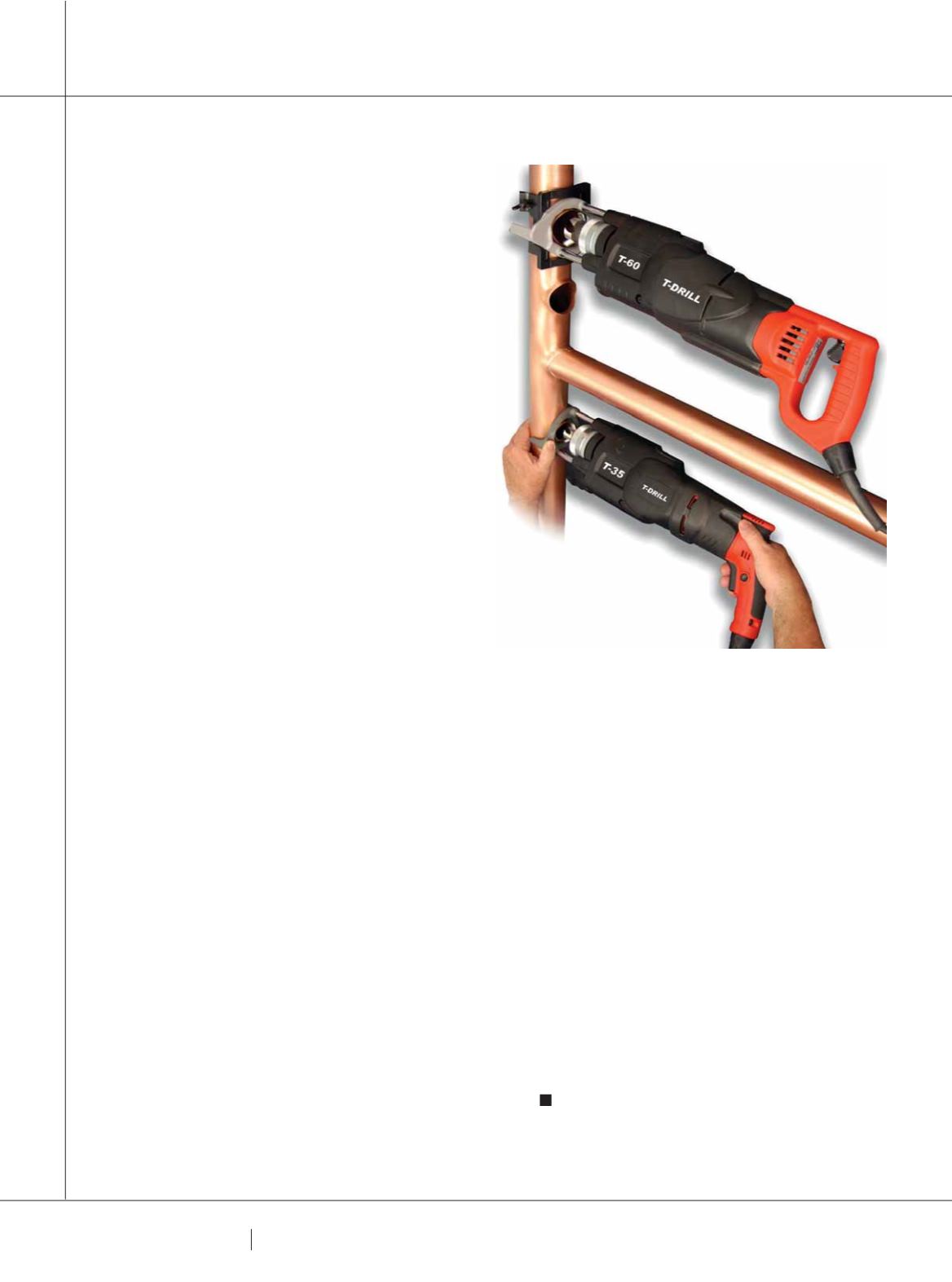

5 0
PLUMBING CONNECTION
AUTUMN 2016
TO A TEE
E
very now and again, a great tool will come onto the
market and remain undiscovered by a large portion of
the industry for some time. T-Drill has been around,
in various incarnations, for about 30 years so it’s surprising
how many plumbers are yet to hear about it. At
Plumbing
Connection
we thought we’d remedy the situation and give
our readers a bit of a run down on what this capable machine
can do.
T-Drill is an all-in-one tool that can significantly reduce
job time for plumbers when forming tee branches in pipe
work – without the use of tee pieces. The tool works by first
drilling a pilot hole in the main tube, and then raising a collar
from the material surrounding the hole as the head retracts.
This action is made possible by two forming pins built into
the T-Drill head, these can be extended after the pilot hole
has been drilled by pulling back on the head and turning it
counter clockwise.
The branch pipe is then inserted and sealed by brazing.
Because the collar is formed so accurately, when it is brazed
the solder flows around the joint by itself under capillary
action. A branch made in this way is very strong and can
easily withstand the forces the pipe network is subjected to.
Bevis and Bartels are specialised commercial plumbers
who focus on large scale hydraulic and drainage works.
They install plumbing and drainage systems to major
construction facilities in Queensland and use T-Drill
regularly.
“We used to use a hand set of branch pullers. To make a
branch you’d have to put a drill bit onto a drill, adjust it to
whatever size branch you were drilling, and drill the hole.
Once that was done, you’d place the bobbin in the hole and
wind that out by hand with a ratchet. Then you would get
out the crimping tool and put a nipple on the pipe that you’re
feeding in so it doesn’t protrude into the pipe, then you
need to square it up and weld it. So you’d have three moving
parts, but with the T-Drill it’s all in one. You do still need the
crimping tool but T-Drill is still a lot quicker and it’s all in one
box,” foreman at Bevis and Bartels Leith Naismith says.
Because T-Drill creates consistent joins, any chance of
leakage is greatly reduced. With support legs that keep the
tool centred on the tubing, and the ability to pull a tee in a
matter of seconds, the margin for error is minimalised while
saving significant amounts of time.
A TOOL THAT CAN HELP PLUMBERS TO FORM
TEES FASTER AND EASIER, WHILE PRODUCING
CONSISTENTLY STRONG JOINS, IS ALWAYS GOING TO
BE WORTH A LOOK.
PLUMBING CONNECTION
CHECKS
OUT T-DRILL.
The unique T-Drill action is made possible due to the T-Drill
head: it both drills and forms a collar.
TOOLS
Contact: Edro
www.edro.com.au“We mark a route on the floor for the pipe work that’s
going to hang in the air. Then we place the pipe on the
measurements from elbow to elbow (or on straight runs,
mark where the tee’s going to be), lift it off the floor into a
vice. Then just grab the T-Drill and pull your branches. Once
that’s done your pipe and everything’s ready to go up into
the air in that location, with the tees in place. Each branch
you drill is exactly the same, so once the tool is set to the
thickness of the copper you can forget it, we haven’t had any
adjustment problems with it on the way through,” Leith says.
The unique T-Drill action is made possible due to the
T-Drill head: it both drills and forms a collar. The drill core is
made of hardened steel, and the forming pins are shaped so
that they do not cause any breaks or metallurgical changes
in the collar, which would reduce the strength of the joint.
The design of the T-Drill head is basically very simple. It is
robust, withstands heavy use and is easy to service.
“Time, as we know, is money nowadays – so considering
the time it saves and the ease in which it works it is a great
tool.”
















